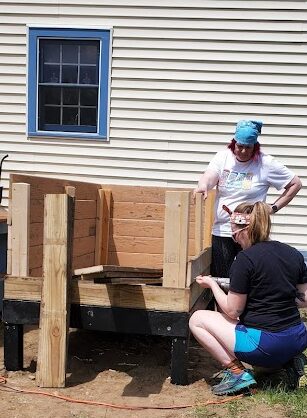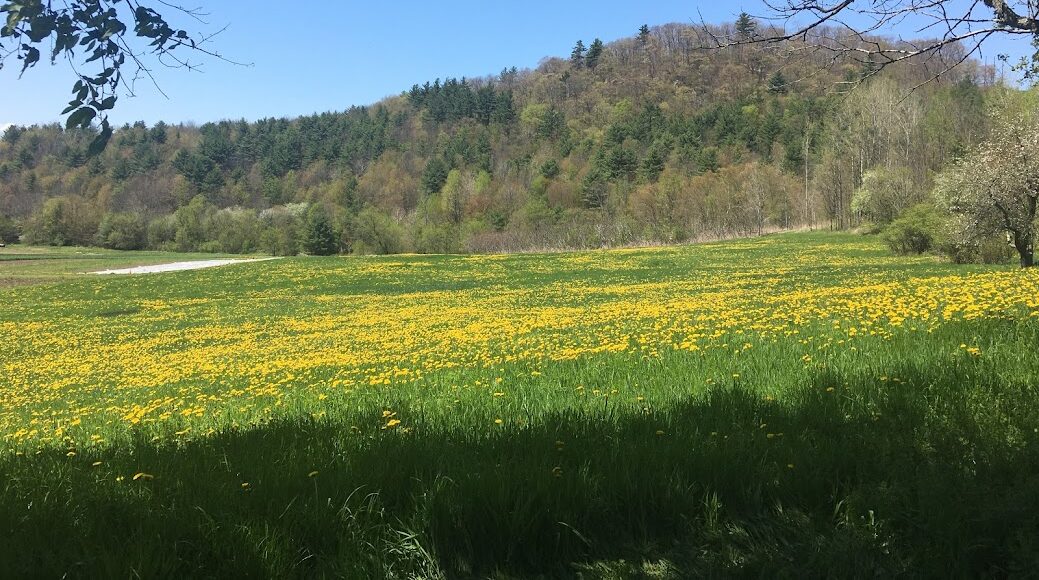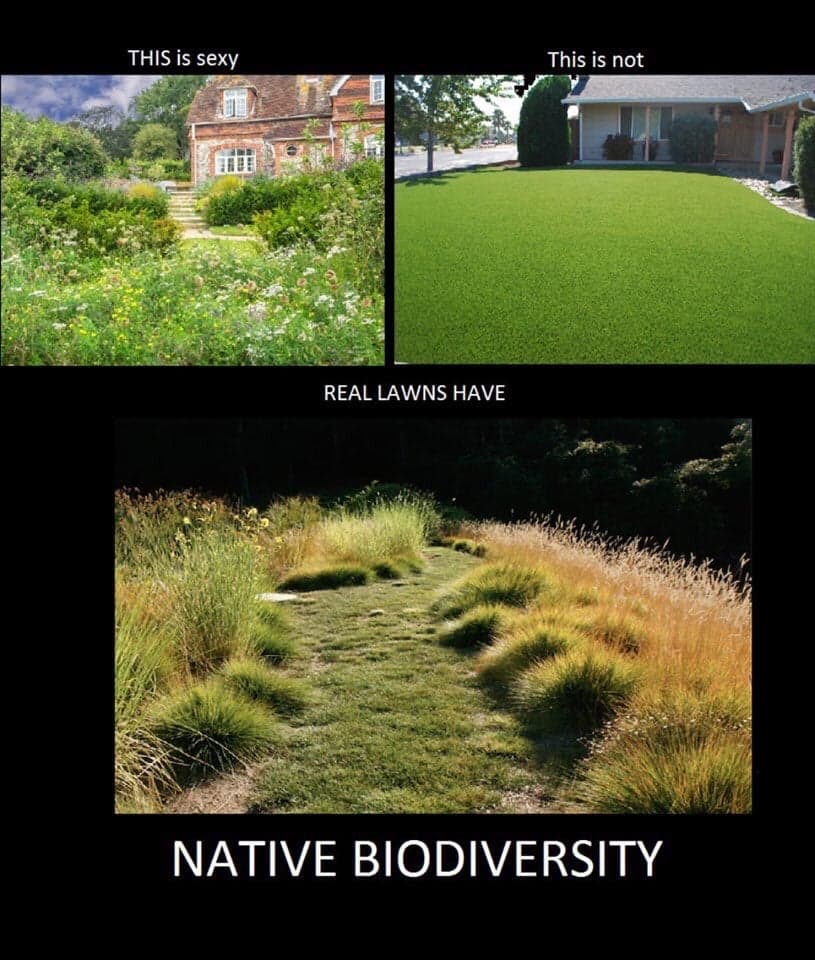
A short story about grass
Lawns are perhaps one of the most controversial spaces when it comes to improving landscapes for wildlife. When I was in college, I threw myself head first into becoming more “green”, which for me meant being the best environmental and eco-friendly entomologist I could be. That meant changing not only my own habits, but those of my parents who, fortunately for me and maybe less fortunately for them, lived only thirty minutes away from my university.
It started with composting. After we got over the discussion about how to properly care for an indoor bin to avoid fruit flies AND my mom saw how much deliciously rich soil her dear friend yielded from her own bin, composting was a hit. My mom still tells me how amazed she is by how quickly the pile reduces every spring. I’m still surprised as to how easy of a practice it was for them to adopt.
The topics that came next were bees, buying local, what organic means, reusable everything, why you should check the insulation on the house before even thinking about buying solar panels, and then, after I took two landscape design courses, we approached the topic of grass. For this talk, which actually spanned months, I came prepared with books, quotations, and 3 or 4 finely detailed maps with elaborate plans for turning my parent’s yard into a pollinator sanctuary.

I began with dropping hints that this talk was coming. I would casually add “lawns should be like area rugs, not wall to wall carpeting” into a conversation, or post graphics like the one at the beginning of this blog on Facebook, and tag my parents in it. I even gave my dad Noah’s Garden: Restoring the Ecology of our Own Backyards by Sara Stein for Father’s Day. I knew this was a change that would take a lot more time than the compost.
Truthfully, I started with my mom. She’s the outdoor gardener, my dad is the houseplant guy. And, as anyone who has ever been a child knowns, there’s always one parent or guardian you go to first for the more difficult requests. For the most part, my mom was excited to see me become a budding naturalist. Around the house or on hikes I would point out plants I now knew the names of, and together we would assess the basal leaves of new garden growth, trying to figure out what in the world did she plant next to the lupine in the garden last year. When I got my wisdom teeth removed, she and the nurse patiently waited while I explained how to identify the red oak next to the car from other common oaks planted as street trees. I made it my mission to make my mom a budding naturalist, too.

When my landscape design class ended, I took my mom on a tour of her property, pointing out all of the potential diversity their landscape could support if they turned it into something beyond grass. I described the changes I recommended, I explained the benefits of the rain gardens, the swales, the terraced lowbush blueberries for the front yard, the beautiful meadow that would grow in the seasonal wet spot in the backyard and enhance the firefly populations we see glowing in the summer. I explained that though the initial transition would take a lot of work, the result would be significantly less maintenance for them, and they would sit atop the ecological design of my dreams. And there would be so much less lawn, err grass for them to mow.
Nearly 10 years later, I am reluctant to report that the quantity of grass covering my parents’ landscape remains relatively similar. The problem with my plan? I went too big. If mom was not ready to completely transform 3.5 acres, then dad certainly would not be either. Though they both appreciated and complemented my thoughtfulness and the rigor behind my design work when I reviewed it with them, my bold idea of turning the yard into a part pick your own blueberry farm and part pollinator paradise certainly scared them from asking my opinion on any further garden projects for a while.
I refused to let this setback alter my new found passion for increasing the value of my childhood home (to wildlife). I continue to share information with my parents, but in small doses rather than in huge design plans. My mom happily adds native plants we pick out together to her gardens and excitedly reports back about the bees she sees visiting them. They’ve added a small planting of mint outside the kitchen to keep the ants at bay, and when it comes to the lawn, they don’t mind leaving the dandelions and other wildflowers (“weeds”) for wildlife to snack on in the spring. And they’re not afraid of asking my advice on new plants or yard projects, though they don’t always utilize it.
Perhaps the most important result of my collegiate mission for Making the Hayes Family Eco-Conscious was helping my parents to see their yard differently, to help them see the potential that exists underneath all of the grass. I hope part two of this blog post might make you do just the same.

No mow May & reimagining our yards
No mow may is an initiative that started in the United Kingdom and has since spread to numerous other countries. To participate is relatively simple: don’t mow your lawn for the month of May. The goals of the initiative include increasing forage for pollinators and other wildlife, and creating awareness about the negative ecological impact of intensively managed lawns.
The practice of reducing mowing to promote diversity is supported by research. A meta-analysis of studies from North America and Europe found that both plant diversity and invertebrate diversity is higher in urban lawns with a lower mowing intensity. This increase in diversity was true regardless of mowing height or frequency, and the authors also found that weeds and invertebrate pests occurred in higher quantities with intensive mowing in many Northern regions.
In terms of surface area, the largest irrigated crop in the United States is lawn. Our idyllic front and backyard monocultures have been cultivated as such to meet the dominant neat and tidy aesthetic. This aesthetic has been so deeply wound into our culture that untidy yards are accused of being a sign of disrespect to one’s neighbors. The impact is such that if you choose to maintain a yard outside of this aesthetic, you have defend yourself against your neighbors with signage.
Perhaps some of this discomfort with weedy yards is due to misinformation- common wildflowers like dandelions, goldenrod, and even sneezeweed have poor reputations because they are thought to cause seasonal allergies. Insect-pollinated plants, which all three of these happen to be, actually shed very little pollen into the air. These plants have co-evolved with their insect pollinators, such that insect-collected pollen grains are actually often larger and/or heavier than those of wind-pollinated plants, and as a result, their pollen cannot easily drift into our respiratory tracts. Many tree species and grasses (which we in the Willamette Valley know all too well about) are more likely to be the culprit for seasonal pollen allergens.
Whether it’s the allergens, the HOA, city standards, your landlord, your own personal preference, or societal pressures that encourage you to keep your yard tidy, there are many small ways in which to increase the productivity and diversity in your landscape. One option is No Mow May- committing to the whole month, or even part of it, to increase the availability of flora to early emerging invertebrates. Reducing mowing frequency is another option, or mowing around weeds like hedge nettle, creeping Charlie, heal-all and others that you may find some insects foraging on. Or perhaps you can replace a small section of lawn a native plant garden, or butterfly garden, or plant some giant sunflowers for the birds.



I have compiled a few resources related to No Mow May below, in addition to some more “neighborly” ways you can begin changing your own yard’s aesthetic. If you decide to go No Mow May, we’d love to hear about your experience!
“A weed is a flower in the wrong place” – Ian Emberson
Resources
Plantlife: No Mow May
Bee City USA: No Mow May
PennState Extension: Neighborly Natural Landscaping in Residential Areas
Buzzing and Beautiful: Designing Pollinator Gardens with OSU Extension
OSU Extension: Enhancing Urban and Suburban Landscapes to Protect Pollinators
A Tribute To The Monarch Butterfly: How to Turn Your Backyard Into a Butterfly Friendly Habitat
Fine Gardening: Defining the New American Cottage Garden (my personal favorite aesthetic!)
www.healthyyards.org






